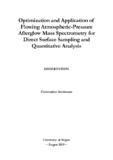Citation link:
https://doi.org/10.25819/ubsi/1012Files in This Item:
| File | Description | Size | Format | |
|---|---|---|---|---|
| Dissertation_Christopher_Kuhlmann.pdf | 11.99 MB | Adobe PDF |  View/Open |
| Dokument Type: | Doctoral Thesis | metadata.dc.title: | Optimization and application of flowing atmospheric-pressure afterglow mass spectrometry for direct surface sampling and quantitative analysis | Other Titles: | Optimierung und Anwendung der Flowing Atmospheric-Pressure Afterglow Quelle für die Massenspektrometrie zur direkten Oberflächenbeprobung und quantitativen Analyse Optimierung und Anwendung der Flowing Atmospheric-Pressure Afterglow Quelle für die Massenspektrometrie zur direkten Oberflächenbeprobung und quantitativen Analyse |
Authors: | Kuhlmann, Christopher | Institute: | Fakultät IV - Naturwissenschaftlich-Technische Fakultät Department Chemie - Biologie |
Free keywords: | Flowing Atmospheric-Pressure Afterglow, Mass Spectrometry, Ambient Desorption/Ionization, Quantitative Analysis, Mass Spectral Imaging | Dewey Decimal Classification: | 540 Chemie | GHBS-Clases: | UUI UUN UZS |
Issue Date: | 2019 | Publish Date: | 2020 | Abstract: | Ambient desorption/ionization mass spectrometry (ADI-MS) has emerged as an important field for direct sample analysis since the mid-2000s, when desorption electrospray ionization (DESI) and direct analysis in real time (DART) were introduced. The main goal of ADI-MS is to minimize sample preparation procedures (e.g., solvent extraction) and to overcome the long analysis times, often encountered with chromatographic separations, by directly desorbing the target analytes from the sample surface. In the first part of this thesis, a brief summary and review will highlight the main achievements for the optimization of plasma-based ADI sources, which can be found in peer-reviewed journal articles. These ADI source optimization parameters are important to improve the methods sensitivity for fast analyte screening and direct surface analysis. Subsequently to this literature overview, own studies for the optimization of instrumental parameters for the flowing atmospheric-pressure afterglow (FAPA) source will be presented in a following chapter. In the second section of the thesis, DART-MS, FAPA-MS, and low-temperature plasma mass spectrometry (LTP-MS), are compared for the direct analysis of liquid-crystalline materials by MS. With this approach sample preparation is minimized for quick and cheap liquid crystal display (LCD) failure analysis. For DART-MS limits of detection (LODs, absolute amount) in the ng range and for LTP- and FAPA-MS LODs in the pg range are obtained. Additionally, mass-spectral imaging of LCDs by FAPA-MS and laser ablation halo-FAPA-MS (LA-h-FAPA-MS) will be presented. This instrumental setup enables the analysis of very low sample volumes inside an LCD and first experiments suggest an estimated spatial resolution of 1-2 mm and 0.6 mm for FAPA-MS and LA-h-FAPA-MS, respectively. Ultimately, these methods shall help to discriminate between different LCD components and to identify defects within an LCD by lateral profiling. Despite the versatile application possibilities for ADI-MS methods, these techniques are very sensitive to matrix effects. Thus, thin-layer chromatography (TLC) is used to quickly separate matrix components and reaction byproducts from the target analytes before spatial resolved and quantitative detection by FAPA-MS. Furthermore, different TLC stationary phases (e.g., normal phase, reversed phase, and cyano phase) as well as different particle sizes of the stationary phase are compared for best performance. Moreover, a validated TLC-FAPA-MS method is developed for quantification of 0.32 mg/mL caffeine in energy drinks via stable isotope dilution analysis. A second application involves the separation and individual detection of active agents in antimalarial preparations. Finally, FAPA-MS is applied for the analysis of a P4O10 in DMSO mixture, to elucidate the reaction mechanism between both compounds. With these measurements the presence of the important C2H5S+ intermediate product could be confirmed. Seit der Einführung von Desorption Electrospray Ionization (DESI) und Direct Analysis in Real Time (DART) haben sich Ambient Desorption/Ionization Mass Spectrometry (ADI-MS) Techniken zu nachweisstarken analytischen Werkzeugen entwickelt. ADI-MS Methoden ermöglichen es, Analyten direkt von der Probenoberfläche zu desorbieren und massenspektrometrisch zu untersuchen. Hierdurch können zeitaufwändige Probenvorbereitungsschritte (z.B. durch Lösungsmittelextraktion) umgangen und lange Analysenzeiten von chromato-graphischen Trenntechniken vermieden werden. Im ersten Teil dieser Dissertation wird eine Übersicht der literaturbekannten Optimierungsparameter zusammengestellt. Wichtige Zusammenhänge dieser Parameter werden für die direkte Oberflächenanalyse durch plasma-basierte ADI-MS Techniken diskutiert. Darüber hinaus werden eigene Ergebnisse zur Optimierung von Geräteeinstellungen für die Flowing Atmospheric-Pressure Afterglow (FAPA)-Quelle präsentiert. Im zweiten Teil dieser Dissertation werden DART-, FAPA- und Low-Temperature Plasma (LTP) Quellen für die direkte massenspektrometrische Analyse von Flüssigkristallen und deren Gemische miteinander verglichen. Zielsetzung ist es diese Substanzen direkt auf der Oberfläche von geöffneten Liquid Crystal Displays (LCDs) zu analysieren, um die zeitaufwändige Probenvorbereitung zur Untersuchung von LCD-Fehlstellen zu minimieren. Im Vergleich der ADI-Quellen können für DART-MS Limits of Detection (LODs) im ng-Bereich und für LTP- und FAPA-MS LODs im pg-Bereich gezeigt werden. Darüber hinaus wird eine Methode zur ortsaufgelösten Analyse von LCD-Fehlstellen mittels FAPA-MS und Laser Ablation halo-FAPA-MS (LA-h-FAPA-MS) vorgestellt, die näherungsweise eine örtliche Auflösung von 1-2 mm bzw. 0.6 mm für die jeweilige Methoden bietet. Auf Grund der Anfälligkeit von ADI-MS Methoden für Matrixeffekte wird Thin-Layer Chromatography (TLC) zur schnellen Abtrennung von Matrix-bestanteilen und Reaktionsnebenprodukten eingesetzt. In diesem Zusammenhang wird eine validierte Methode zur quantitativen Bestimmung von 0,32 mg/mL Coffein in Energydrinks durch TLC-FAPA-MS vorgestellt. In einer zweiten Applikation werden Bestanteile aus Antimalaria Medikamenten durch TLC getrennt, um sie ortsaufgelöst zu detektieren. Zudem wird der Einfluss von verschiedenen TLC Phasen (z.B. unterschiedliche Oberflächenmodifikationen oder Partikelgrößen der stationären Phase) auf das detektierte Ionensignal von Modelsubstanzen untersucht. Abschließend wird FAPA-MS für die direkte Analyse von P4O10 in DMSO angewendet um den Reaktionsmechanismus zwischen den beiden Substanzen aufzuklären. Durch diese Messungen kann die Anwesenheit eines C2H5S+ Intermediat in der Reaktionslösung bestätigt werden. |
DOI: | https://doi.org/10.25819/ubsi/1012 | URN: | urn:nbn:de:hbz:467-15722 | URI: | https://dspace.ub.uni-siegen.de/handle/ubsi/1572 |
| Appears in Collections: | Hochschulschriften |
This item is protected by original copyright |
Page view(s)
623
checked on Dec 26, 2024
Download(s)
489
checked on Dec 26, 2024
Google ScholarTM
Check
Altmetric
Items in DSpace are protected by copyright, with all rights reserved, unless otherwise indicated.

